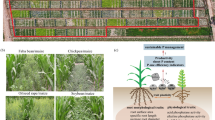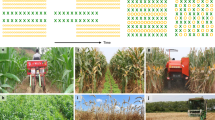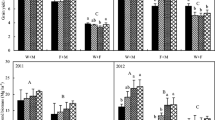Abstract
Background and aims
Enhanced crop productivity by intercropping is commonly assumed to be driven by resource complementarity. However, relatively few studies have directly measured resource acquisition to assess potential mechanisms underlying enhanced performance of intercropping.
Methods
A long-term field experiment with three P application rates (0, 40, 80 kg P ha−1 yr.−1) and four maize-based intercropping systems was used to assess P acquisition and P fertilizer recovery efficiency (PRE) for three consecutive years. To identify underlying mechanisms, the additive partitioning method was applied to determine complementarity (CE) and selection effects (SE) in P acquisition of intercropping.
Results
Average P acquisition increased by 28.4% and 27.6% compared to their monocultures in faba bean/maize and chickpea/maize intercropping, respectively. However, P acquisition was generally not enhanced and even reduced in the last year in soybean/maize and oilseed rape/maize intercropping. Enhanced P acquisition was due to positive CE in faba bean/maize, and to positive CE and SE in chickpea/maize intercropping.
Conclusions
Increased resource acquisition via CE and/or SE depended on the particular crop combination in intercropping systems. Application of the additive partitioning method to intercropping may help to identify underlying mechanisms of overyielding and carefully select crop combinations to enable more efficient resource use.





Similar content being viewed by others
Abbreviations
- CE:
-
Complementarity effect
- C/M:
-
Chickpea/maize system
- F/M:
-
Faba bean/maize system
- N:
-
Nitrogen
- OR/M:
-
Oilseed rape/maize system
- P:
-
Phosphorus
- PRE:
-
Phosphorus fertilizer recovery efficiency
- RY:
-
Relative yield
- SE:
-
Selection effect
- S/M:
-
Soybean/maize system
References
Ae N, Arihara J, Okada K, Yoshihara T, Johansen C (1990) Phosphorus uptake by pigeon pea and its role in cropping systems of the Indian subcontinent. Science 248:477–480
Bao SD (2005) Analysis on soil and agricultural chemistry (in Chinese). China Agricultural Press, Beijing
Barot S, Allard V, Cantarel A, Enjalbert J, Gauffreteau A, Goldringer I, Lata J-C, Le Roux X, Niboyet A, Porcher E (2017) Designing mixtures of varieties for multifunctional agriculture with the help of ecology. A review. Agron Sustain Dev 37:13
Bedoussac L, Journet EP, Hauggaard-Nielsen H, Naudin C, Corre-Hellou G, Jensen E, Prieur L, Justes E (2015) Ecological principles underlying the increase of productivity achieved by cereal-grain legume intercrops in organic farming. A review. Agron Sustain Dev 35:911–935
Bieleski RL (1973) Phosphate pools, phosphate transport, and phosphate availability. Annu Rev Plant Physiol Plant Mol Biol 24:225–252
Brooker RW, Bennett AE, Cong W-F, Daniell TJ, George TS, Hallett PD, Hawes C, Iannetta PPM, Jones HG, Karley AJ, Li L, McKenzie BM, Pakeman RJ, Paterson E, Schoeb C, Shen J, Squire G, Watson CA, Zhang C, Zhang F, Zhang J, White PJ (2015) Improving intercropping: a synthesis of research in agronomy, plant physiology and ecology. New Phytol 206:107–117
Broz AK, Broeckling CD, De-la-Pena C, Lewis MR, Greene E, Callaway RM, Sumner LW, Vivanco JM (2010) Plant neighbor identity influences plant biochemistry and physiology related to defense. BMC Plant Biol 10:115
Cahill JF, McNickle GG, Haag JJ, Lamb EG, Nyanumba SM, Clair CCS (2010) Plants integrate information about nutrients and neighbors. Science 328:1657–1657
Callaway RM (2007) Positive interactions and interdependence in plant communities. Springer Verlag, Dordrecht
Cardinale BJ, Wright JP, Cadotte MW, Carroll IT, Hector A, Srivastava DS, Loreau M, Weis JJ (2007) Impacts of plant diversity on biomass production increase through time because of species complementarity. Proc Natl Acad Sci U S A 104:18123–18128
Chien SH, Sikora FJ, Gilkes RJ, McLaughlin MJ (2012) Comparing of the difference and balance methods to calculate percent recovery of fertilizer phosphorus applied to soils: a critical discussion. Nutr Cycl Agroecosyst 92:1–8
Cong WF, Hoffland E, Li L, Six J, Sun JH, Bao XG, Zhang FS, van der Werf W (2015) Intercropping enhances soil carbon and nitrogen. Global Chang Biol 21:1715–1726
Corre-Hellou G, Fustec J, Crozat Y (2006) Interspecific competition for soil N and its interaction with N2 fixation, leaf expansion and crop growth in pea-barley intercrops. Plant Soil 282:195–208
Cu STT, Hutson J, Schuller KA (2005) Mixed culture of wheat (Triticum aestivum L.) with white lupiu (Lupinus albus L.) improves the growth and phosphorus nutrition of the wheat. Plant Soil 272:143–151
Dissanayaka DMSB, Maruyama H, Masuda G, Wasaki J (2015) Interspecific facilitation of P acquisition in intercropping of maize with white lupin in two contrasting soils as influenced by different rates and forms of P supply. Plant Soil 390:223–236
Ehrmann J, Ritz K (2014) Plant: soil interactions in temperate multi-cropping production systems. Plant Soil 376:1–29
Fargione J, Tilman D, Dybzinski R, Hille Ris Lambers J, Clark C, Harpole WS, Knops JMH, Reich PB, Loreau M (2007) From selection to complementarity: shifts in the causes of biodiversity-productivity relationships in a long-term biodiversity experiment. Proc R Soc B-Biol Sci 274:871–876
Fridley JD (2001) The influence of species diversity on ecosystem productivity: how, where, and why? Oikos 93:514–526
Fridley JD (2002) Resource availability dominates and alters the relationship between species diversity and ecosystem productivity in experimental plant communities. Oecologia 132:271–277
Fridley JD (2003) Diversity effects on production in different light and fertility environments: an experiment with communities of annual plants. J Ecol 91:396–406
Gilbert N (2009) Environment: the disappearing nutrient. Nature 461:716–718
Hauggaard-Nielsen H, Jensen ES (2005) Facilitative root interactions in intercrops. Plant Soil 274:237–250
Hauggaard-Nielsen H, Gooding M, Ambus P, Corre-Hellou G, Crozat Y, Dahlmann C, Dibet A, von Fragstein P, Pristeri A, Monti M, Jensen ES (2009) Pea-barley intercropping for efficient symbiotic N2-fixation, soil N acquisition and use of other nutrients in European organic cropping systems. Field Crops Res 113:64–71
He Q, Bertness MD, Altieri AH (2013) Global shifts towards positive species interactions with increasing environmental stress. Ecol Lett 16:695–706
Hector A, Schmid B, Beierkuhnlein C, Caldeira MC, Diemer M, Dimitrakopoulos PG, Finn JA, Freitas H, Giller PS, Good J, Harris R, Hogberg P, Huss-Danell K, Joshi J, Jumpponen A, Korner C, Leadley PW, Loreau M, Minns A, Mulder CPH, O'Donovan G, Otway SJ, Pereira JS, Prinz A, Read DJ, Scherer-Lorenzen M, Schulze ED, Siamantziouras ASD, Spehn EM, Terry AC, Troumbis AY, Woodward FI, Yachi S, Lawton JH (1999) Plant diversity and productivity experiments in European grasslands. Science 286:1123–1127
Hinsinger P, Betencourt E, Bernard L, Brauman A, Plassard C, Shen J, Tang X, Zhang F (2011) P for two, sharing a scarce resource: soil phosphorus acquisition in the rhizosphere of intercropped species. Plant Physiol 156:1078–1086
Huston MA (1997) Hidden treatments in ecological experiments: re-evaluating the ecosystem function of biodiversity. Oecologia 110:449–460
Inal A, Gunes A, Zhang F, Cakmak I (2007) Peanut/maize intercropping induced changes in rhizosphere and nutrient concentrations in shoots. Plant Physiol Biochem 45:350–356
Jensen ES (1996) Grain yield, symbiotic N2 fixation and interspecific competition for inorganic N in pea-barley intercrops. Plant Soil 182:25–38
Jiao XQ, Li HG, Rengel Z, Zhang FS, Shen JB (2015) Dynamic growth pattern and exploitation of soil residual P by Brassica campestris throughout growth cycle on a calcareous soil. Field Crops Res 180:110–117
Lambers H, Shane MW, Cramer MD, Pearse SJ, Veneklaas EJ (2006) Root structure and functioning for efficient acquisition of phosphorus: matching morphological and physiological traits. Ann Bot 98:693–713
Li L, Zhang FS, Li XL, Christie P, Sun JH, Yang SC, Tang CX (2003) Interspecific facilitation of nutrient uptake by intercropped maize and faba bean. Nutr Cycl Agroecosyst 65:61–71
Li SM, Li L, Zhang FS, Tang C (2004) Acid phosphatase role in chickpea/maize intercropping. Ann Bot 94:297–303
Li L, Li SM, Sun JH, Zhou LL, Bao XG, Zhang HG, Zhang FS (2007) Diversity enhances agricultural productivity via rhizosphere phosphorus facilftation on phosphorus-deficient soils. Proc Natl Acad Sci U S A 104:11192–11196
Li C, Dong Y, Li H, Shen J, Zhang F (2014a) The dynamic process of interspecific interactions of competitive nitrogen capture between intercropped wheat (Triticum aestivum L.) and faba bean (Vicia faba L.) PLoS One 9:e115804
Li L, Tilman D, Lambers H, Zhang FS (2014b) Plant diversity and overyielding: insights from belowground facilitation of intercropping in agriculture. New Phytol 203:63–69
Li B, Li YY, HM W, Zhang FF, Li CJ, Li XX, Lambers H, Li L (2016) Root exudates drive interspecific facilitation by enhancing nodulation and N2 fixation. Proc Natl Acad Sci U S A 113:6496–6501
Lithourgidis A, Dordas C, Damalas C, Vlachostergios D (2011) Annual intercrops: an alternative pathway for sustainable agriculture. Aust J Crop Sci 5:396–410
Loreau M (1998) Separating sampling and other effects in biodiversity experiments. Oikos 82:600–602
Loreau M, Hector A (2001) Partitioning selection and complementarity in biodiversity experiments. Nature 412:72–76
Lynch JP (2011) Root phenes for enhanced soil exploration and phosphorus acquisition: tools for future crops. Plant Physiol 156:1041–1049
Mei PP, Gui LG, Wang P, Huang JC, Long HY, Christie P, Li L (2012) Maize/faba bean intercropping with rhizobia inoculation enhances productivity and recovery of fertilizer P in a reclaimed desert soil. Field Crops Res 130:19–27
Mollier A, Pellerin S (1999) Maize root system growth and development as influenced by phosphorus deficiency. J Exp Bot 50:487–497
Poorter H, Niklas KJ, Reich PB, Oleksyn J, Poot P, Mommer L (2012) Biomass allocation to leaves, stems and roots: meta-analyses of interspecific variation and environmental control. New Phytol 193:30–50
Reich PB, Tilman D, Isbell F, Mueller K, Hobbie SE, Flynn DFB, Eisenhauer N (2012) Impacts of biodiversity loss escalate through time as redundancy fades. Science 336:589–592
STT C, Hutson J, Schuller KA (2005) Mixed culture of wheat (Triticum aestivum L.) with white lupiu (Lupinus albus L.) improves the growth and phosphorus nutrition of the wheat. Plant Soil 272:143–151
Tilman D (1999) The ecological consequences of changes in biodiversity: a search for general principles. Ecology 80:1455–1474
van Ruijven J, Berendse F (2003) Positive effects of plant species diversity on productivity in the absence of legumes. Ecol Lett 6:170–175
Vance CP, Uhde-Stone C, Allan DL (2003) Phosphorus acquisition and use: critical adaptations by plants for securing a nonrenewable resource. New Phytol 157:423–447
Vandermeer J (1989) The ecology of intercropping. Cambridge University Press, Cambridge, UK
Vitousek PM, Porder S, Houlton BZ, Chadwick OA (2010) Terrestrial phosphorus limitation: mechanisms, implications, and nitrogen-phosphorus interactions. Ecol Appl 20:5–15
Wang DM, Marschner P, Solaiman Z, Rengel Z (2007) Growth, P uptake and rhizosphere properties of intercropped wheat and chickpea in soil amended with iron phosphate or phytate. Soil Biol Biochem 39:249–256
Wang ZG, Jin X, Bao XG, Li XF, Zhao JH, Sun JH, Christie P, Li L (2014) Intercropping enhances productivity and maintains the most soil fertility properties relative to sole cropping. PLoS One 9:e113984
Wang ZG, Bao XG, Li XF, Jin X, Zhao JH, Sun JH, Christie P, Li L (2015) Intercropping maintains soil fertility in terms of chemical properties and enzyme activities on a timescale of one decade. Plant Soil 391:265–282
Xia HY, Wang ZG, Zhao JH, Sun JH, Bao XG, Christie P, Zhang FS, Li L (2013) Contribution of interspecific interactions and phosphorus application to sustainable and productive intercropping systems. Field Crops Res 154:53–64
Yu Y, Stomph TJ, Makowski D, van der Werf W (2015) Temporal niche differentiation increases the land equivalent ratio of annual intercrops: a meta-analysis. Field Crops Res 184:133–144
Zhang FS, Li L (2003) Using competitive and facilitative interactions in intercropping systems enhances crop productivity and nutrient-use efficiency. Plant Soil 248:305–312
Zhang QG, Zhang DY (2006) Resource availability and biodiversity effects on the productivity, temporal variability and resistance of experimental algal communities. Oikos 114:385–396
Zhang FS, Shen JB, Zhang JL, Zuo YM, Li L, Chen XP (2010) Rhizosphere processes and management for improving nutrient use efficiency and crop productivity: implications for China. Adv Agron 107:1–32
Acknowledgements
This work was supported by funds from the National Key Research and Development Program of China (Project No.: 2016YFD0300202) and the National Science Foundation of China (Project No.: 31430014). We thank all members involved in the maintenance of the long-term field experiment. The authors also thank the editor and two anonymous reviewers for their helpful suggestions and comments to improve an earlier version of the manuscript.
Author information
Authors and Affiliations
Corresponding author
Additional information
Responsible Editor: Martin Weih.
Rights and permissions
About this article
Cite this article
Li, XF., Wang, CB., Zhang, WP. et al. The role of complementarity and selection effects in P acquisition of intercropping systems. Plant Soil 422, 479–493 (2018). https://doi.org/10.1007/s11104-017-3487-3
Received:
Accepted:
Published:
Issue Date:
DOI: https://doi.org/10.1007/s11104-017-3487-3




